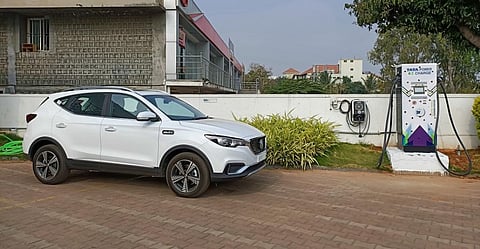

India can slash emissions of volatile organic molecules (VOC) by 76 per cent in the next eight years by swapping all two- and three-wheelers with electric vehicles and all diesel-fuelled ones with Compressed Natural Gas (CNG), a new study has predicted.
VOCs are carbon-containing chemicals released by petrol and diesel vehicles. They impact air quality and human health.
However, VOCs can have a natural origin, too. Plants emit these chemicals to attract pollinators, defend themselves from pests and predators and adapt to environmental stress.
Human-made VOCs are a cause for concern, yet they don’t draw enough attention. “It is a crying shame that so far, India does not have a national-level monitoring programme for VOCs,” Vinayak Sinha, associate professor at Indian Institute of Science Education and Research Mohali and one of the study’s authors, told Down To Earth.
Benzene, a chemical that induces cancer, is the only VOC included in the ambient air-quality standards, he added.
The other pollutants considered are Particulate Matter10 (PM10), Particulate Matter2.5 (PM2.5), nitrogen dioxide, sulphur dioxide, carbon monoxide, ozone, ammonia, lead, nickel and benzo(a)pyrene.
VOCs can irritate the eyes, nose and throat, damage body organs and cause cancer.
“Long-term exposure to VOCs is not good because the majority of the VOCs are carcinogenic (cancer-causing),” Parveen Kumar, senior programme manager, Electric Mobility, at the World Resources Institute (WRI), a global research non-profit organisation, told DTE.
We should monitor and take action to control VOC emission, he added. Kumar was not involved with the study.
VOCs can drive the formation of other dangerous pollutants. For instance, they react with sunlight and nitrogen dioxide to form ground-level ozone.
Ground-level ozone is a harmful pollutant that triggers health problems such as cough, difficulty breathing and increases the risk of infections. This pollutant can also aggravate asthma.
VOCs also trigger the formation of PM2.5, a pollutant that reaches deep into the lungs, affecting their normal functioning. It is also linked to medical conditions such as asthma and heart disease.
They react in the air to produce secondary organic aerosols, minute particles suspended in the air. The aerosols, in turn, form a large chunk of PM 2.5, Sinha said.
Sinha and his team have documented the scale and quantity of air pollution from different vehicle sources over the past decade.
They focussed on finding the best solution for cleaner air. The team looked at the number of vehicles expected to ply on Indian roads, projected per capita income and population growth in 2030.
They then evaluated how different potential solutions or scenarios could improve air quality in the future.
They evaluated replacing all petrol, diesel, LPG and CNG fuelled two- and three-wheelers with electric vehicles in 2030. Their analysis showed that non-methane volatile organic compounds’ emissions could fall by 91 per cent.
Non-methane volatile organic compounds (NMVOC) are VOCs minus methane, a greenhouse gas.
Emissions of other pollutants — carbon monoxide, PM2.5, toxic volatile organic compounds, BTEX (Benzene, toluene, ethylbenzene and xylene) — might drop by 80 per cent, 44 per cent, 76 per cent and 93 per cent, respectively.
Next, they predicted air quality outcomes of replacing all diesel-fuelled vehicles with CNG-fuelled ones.
This intervention could lower the emissions of black carbon — a sooty black material coming from gas and diesel-powered vehicles — by 50 per cent. It could act as a short-term strategy for India, the study said.
Black carbon is linked to health problems such as respiratory and cardiovascular disease, cancer and congenital disabilities. It also contributes to climate change.
They then analysed the effects of combining scenarios one and two. Though ambitious, this intervention could be India’s best bet for cleaner air, the researchers said.
The emissions fell by 95 per cent for BTEX, 80 per cent for secondary organic aerosol formation potential and 83 per cent for oxygenated volatile organic compounds, Sinha said.
E-mobility push
India is home to 14 out of the top 20 most polluted cities globally. Around 1.67 million deaths were linked to air pollution in 2019. The country lost 1.36 per cent of its gross domestic product the same year.
Gases escaping out of a vehicle’s exhaust account for 65-80 per cent of an automobile’s emissions. Adopting electric vehicles can help India achieve a cleaner future, according to Kumar.
According to the Union Ministry of Heavy Industries, 239,711 electric vehicles have been sold as of January 8, 2022.
Still, India has a long way to go. China, Europe and the United States account for around 90 per cent of electric car sales. India’s electric cars’ share was less than one per cent of overall sales, according to a commentary from experts at the International Energy Agency (IEA).
Electric two-wheelers are doing relatively better. They account for approximately 61 per cent of the total electric vehicle sales. In 2021, electric two-wheeler penetration in India was 0.95 per cent. It is expected to increase to 47 per cent by 2030, according to the WRI.
“The four-wheeler segment will have a mix of electric, petrol and CNG by 2030,” Kumar told DTE. “The bus segment will have a mix of e-bus, fuel cell e-bus and CNG bus. Electric, CNG, and diesel could power medium commercial and heavy-duty vehicles by 2030.
In 2020, the global electric vehicle fleet consumed over 80 terawatt-hours (TWh) of electricity, equal to the current total electricity demand in Belgium, according to the IEA.
Sinha’s study found that adopting e-mobility is unlikely to overwhelm the electricity sector.
Scenario one would increase power consumption by 76 TWh in 2030, accounting for four per cent of the total electricity intake in the same year.
If four-wheelers and heavy-duty vehicles are added to the mix, intake will rise to 97 TWh — less than five per cent of the total demand during the same year, the study predicted.
In 2030, considering India’s existing policies, policy ambitions and targets, the electricity demand from the electric vehicle fleet could be 45 TWh, the IEA said in its report.